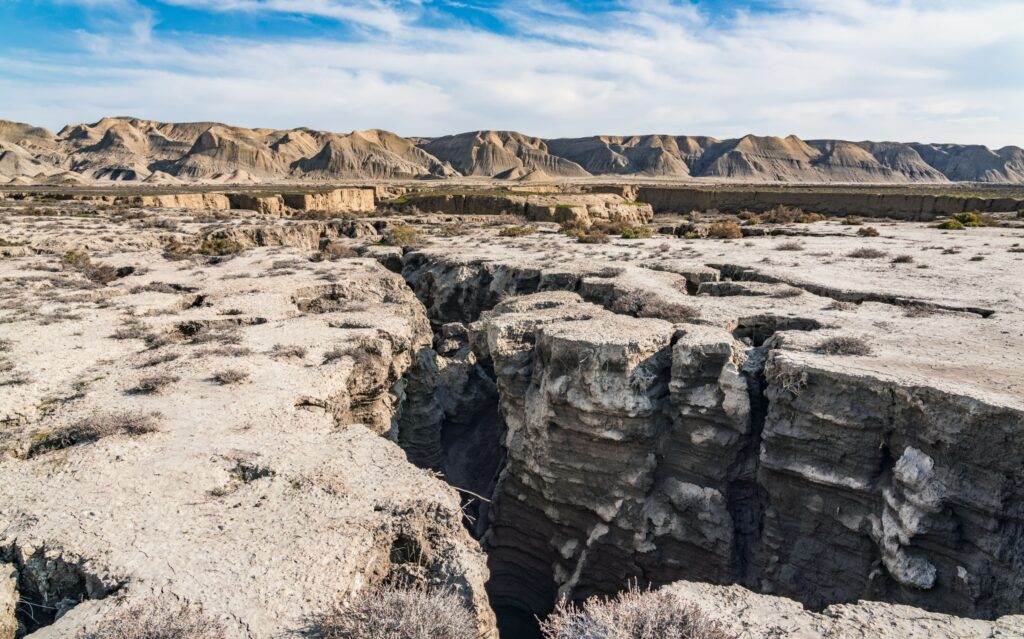
Deep beneath the Earth’s surface, far removed from the sun’s nourishing rays, life finds a way to thrive. Microbes in these shadowy depths harness energy from an unexpected source: the cracking of rocks. A groundbreaking study by researchers from the Guangzhou Institute of Geochemistry, Chinese Academy of Sciences, reveals how fault movements generate hydrogen and oxidants, challenging the long-held belief that sunlight is essential for life.
Professors He Hongping and Zhu Jianxi spearheaded this research, employing high-pressure experiments to simulate the conditions of earthquakes. Their findings indicate that the energy released during these seismic events is sufficient to sustain microbial life deep underground.
Cracks in Rocks: A Surprising Energy Source
Sunlight barely penetrates a few yards into the bedrock, yet the deep biosphere, home to roughly 15 percent of Earth’s biomass, thrives. This ecosystem, primarily composed of bacteria and archaea, is continually rejuvenated by the movement of tectonic plates and daily microquakes. When rocks like quartz or basalt fracture, they release reactive radicals that split water into hydrogen gas and hydrogen peroxide—vital energy sources for these subterranean microbes.
The study’s lead author, Xiao Wu, highlights the significance of this process:
“Hydrogen production driven by earthquake-related faulting was up to 100,000 times greater than that from other known pathways.”
This discovery underscores the potential of rock fractures to outshine sunlight in sustaining life in these hidden realms.
Microbial Life Thrives in the Dark
In laboratory settings, the researchers observed that their simulated faults could produce up to 160 micromoles of hydrogen in just four hours. This output dwarfs the hydrogen yield from processes like serpentinization or natural radiolysis. With production rates reaching 33.1 moles per square yard annually, these bursts of energy can support dense microbial biofilms.
Astrobiologist Tori Hoehler notes that many subsurface cells survive on minimal energy:
“Many subsurface cells scrape by on barely 10⁻¹² watts apiece, near the threshold estimated for metabolic maintenance.”
A single quake can thus provide millions of times the power required by a single microbe, transforming fresh rock cracks into temporary oases.
Iron: The Unsung Hero of Subterranean Life
While hydrogen is crucial, life also requires an electron acceptor. The experiments revealed that reactive hydrogen atoms can convert ferric iron (Fe³⁺) back into ferrous iron (Fe²⁺). Simultaneously, hydrogen peroxide oxidizes Fe²⁺ back to Fe³⁺, creating a self-sustaining iron cycle. Some bacteria exploit this iron exchange to generate energy and support the carbon cycle.
Field samples from deep boreholes in the Canadian Shield corroborate these findings, showing iron shifting between forms over several years. This evidence suggests that underground microbes remain active by utilizing hydrogen from fractured rock, with iron redox shuttles acting as long-term energy reservoirs.
Implications for Life Beyond Earth
The study’s implications extend beyond our planet. Rocky planets with brittle crusts, such as Mars, Europa, or Enceladus, could experience similar fracturing from impacts, tides, and cooling. Mars orbiters have already mapped extensive rock cracks, and rovers have detected iron capable of switching between forms. These findings suggest that similar chemical processes could support life on other worlds.
Tools designed to detect hydrogen, methane, or iron changes might identify signs of life in seemingly barren landscapes. The new data provide mission planners with quantitative targets, focusing the search on rock cracks where chemistry and biology intersect.
Revolutionizing Our Understanding of the Biosphere
Back on Earth, this research broadens our understanding of the deep biosphere. Tectonic activity, glacier movements, and landslides all contribute to seeding underground food chains. As life continues to adapt to its environment, it becomes clear that mechanical energy plays a crucial role in sustaining ecosystems once thought inert.
Even when energy sources dwindle, some microbes enter a dormant state, surviving on minimal energy for millennia. This resilience has been observed in deep South African gold mines, highlighting the adaptability of underground life.
The study, published in Science Advances, not only reshapes our view of Earth’s biosphere but also offers tantalizing hints about the potential for life on other planets. As researchers continue to explore these hidden realms, they uncover the remarkable ways life persists against all odds.
—
Like what you read? Subscribe to our newsletter for engaging articles, exclusive content, and the latest updates. Check us out on EarthSnap, a free app brought to you by Eric Ralls and Earth.com.





